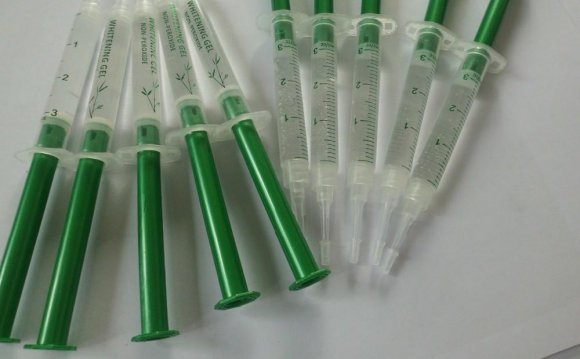
Tooth whitening lightens teeth and helps to remove stains and discoloration. Whitening is among the most popular cosmetic dental procedures because it can greatly improve how your teeth look. Most dentists perform tooth whitening.
Whitening is not a one-time procedure. It will need to be repeated from time to time if you want to maintain the brighter color.
What It's Used For
The outer layer of a tooth is called the enamel. The color of natural teeth is created by the reflection and scattering of light off the enamel, combined with the color of the dentin under it. Your genes affect the thickness and smoothness of the enamel. Thinner enamel allows more of the color of the dentin to show through. Having smoother or rougher enamel also affects the reflection of light and therefore the color.
Every day, a thin coating (pellicle) forms on the enamel and picks up stains. Tooth enamel also contains pores that can hold stains.
The most common reasons for teeth to get yellow or stained are:
- Using tobacco
- Drinking dark-colored liquids such as coffee, cola, tea and red wine
- Not taking good care of your teeth
Aging makes teeth less bright as the enamel gets thinner and the dentin becomes darker.
It is also possible to have stains inside the tooth. These are called intrinsic stains. For example, intrinsic stains can be caused by exposure to too much fluoride as a child while teeth are developing. Other causes include tetracycline antibiotics. They can stain a child's teeth if taken by a mother during the second half of pregnancy or by a child who is 8 years old or younger. Teeth are still developing during these years. Trauma may also darken a tooth.
Tooth whitening is most effective on surface (extrinsic) stains.
Preparation
Other dental problems can affect the success of tooth whitening. For example, cavities need to be treated before teeth are whitened. That's because the whitening solution can pass through decayed areas and reach the inner parts of the tooth. If your gums have receded, the exposed roots of your teeth may appear yellow or discolored. Whitening products will not make them whiter.
If you have tooth decay or receding gums, whitening may make your teeth sensitive. Whitening also does not work on ceramic or porcelain crowns or veneers.
Whitening can be done in the dental office or at home. For in-office whitening, your dentist probably will photograph your teeth first. This step will help him or her to monitor the progress of the treatment. Your dentist also will examine your teeth and ask you questions to find out what caused the staining.
Next, the dentist or a dental hygienist will clean your teeth. This will remove the film of bacteria, food and other substances that build up on your teeth and contribute to the staining. Once this is done, the whitening procedure begins.
For whitening at home, your dentist can make trays to hold the whitening gel that fit your teeth precisely. Home whitening gel usually needs to be applied daily for two to three weeks. Over-the-counter kits also are widely available for home use. They provide trays to hold the gel, or whitening strips that stick to your teeth. Talk to your dentist if you want to use these home products. Be sure to follow directions to avoid overuse and possible damage to your teeth and mouth.
How It's Done
There are two main types of whitening procedures. Vital whitening is performed on teeth that have live nerves. Non-vital whitening is done on a tooth that has had root-canal treatment and no longer has a live nerve.
Vital Whitening
The most common type of vital tooth whitening uses a gel that is applied directly to the tooth surface. This product contains some form of hydrogen peroxide.
Tooth whitening can be done in the dentist's office or at home. In-office whitening allows your dentist to use a more powerful whitening gel. A specialized light or laser activates the gel and allows bleaching to happen faster.
In-office whitening usually takes 30 to 90 minutes. You will need 1 to 3 appointments. The number will depend upon the method used, how severe your stains are and how white you want your teeth to be. Different types of stains respond differently to the treatment.
First, your dentist will apply a substance that covers and protects the gums around the teeth. Then, the whitening agent will be placed on the teeth.
Some whitening agents are activated by a laser light, special lights or by the heat from these lights. After the whitening agent is applied, the dentist will shine the light on your teeth. If they are badly discolored, your dentist may suggest that you continue the bleaching process at home for a few days or weeks.
For in-home whitening, your dentist will take impressions of your upper and lower teeth and will make custom mouthpieces to fit you. The mouthpiece needs to fit well. A close fit helps the whitening agent remain in contact with your teeth.
At home, you will fill each mouthpiece with a whitening gel your dentist provides. You will wear the mouthpiece for several hours every day. Many people achieve the amount of whitening they want within a week or two. However, you may need to wear the mouthpiece for four weeks or longer.
You also can buy whitening products over the counter. They contain a weaker whitening agent than the products you can get from your dentist. Therefore, whitening may take longer. The whitening agent is applied as a gel placed in a mouthpiece or as a strip that sticks to your teeth. Over-the-counter mouthpieces fit less securely than the kind you get from your dentist.









